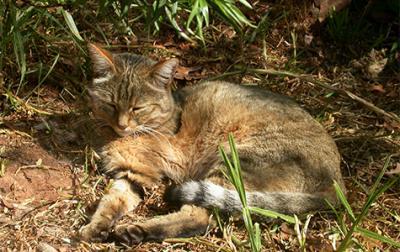Over five-thousand years, cats began living alongside farmers in the ancient Chinese village of Quanhucun, according to a new paper. Probably because of rodents attracted to food.
Cat remains rarely are found in ancient archaeological sites, and little is known about how they were domesticated. Cats were thought to have first been domesticated in ancient Egypt, where they were kept some 4,000 years ago, but more recent research suggests close relations with humans may have occurred much earlier, including the discovery of a wild cat buried with a human nearly 10,000 years ago in Cyprus.
While it often has been argued that cats were attracted to rodents and other food in early farming villages and domesticated themselves, there has been little evidence for this theory.
The evidence for this study is derived from research in China led by Yaowu Hu and colleagues at the Chinese Academy of Sciences. Hu and his team analyzed eight bones from at least two cats excavated from the site.
Using radiocarbon dating and isotopic analyses of carbon and nitrogen traces in the bones of cats, dogs, deer and other wildlife unearthed near Quanhucan, the research team demonstrated how a breed of once-wild cats carved a niche for themselves in a society that thrived on the widespread cultivation of the grain millet.
Carbon isotopes indicate that rodents, domestic dogs and pigs from the ancient village were eating millet, but deer were not. Carbon and nitrogen isotopes show that cats were preying on animals that lived on farmed millet, probably rodents. At the same time, an ancient rodent burrow into a storage pit and the rodent-proof design of grain storage pots indicate that farmers had problems with rodents in the grain stores.

The Near Eastern Wildcat, native to Western Asia and Africa, is believed to be the primary ancestor of all domestic cats now living around the globe. Credit: Wikipedia Commons
Other clues gleaned from the Quanhucun food web suggest the relationship between cats and humans had begun to grow closer. One of the cats was aged, showing that it survived well in the village. Another ate fewer animals and more millet than expected, suggesting that it scavenged human food or was fed.
Recent DNA studies suggest that most of the estimated 600 million domestic cats now living around the globe are descendants most directly of the Near Eastern Wildcat, one of the five Felis sylvestris lybica wildcat subspecies still found around the Old World.
Study co-author Fiona Marshall, PhD, a professor of archaeology in Arts&Sciences at Washington University in St. Louis, said there currently is no DNA evidence to show whether the cats found at Quanhucun are descendants of the Near Eastern Wildcat, a subspecies not native to the area. If the Quanhucun cats turn out to be close descendents of the Near Eastern strain, it would suggest they were domesticated elsewhere and later introduced to the region.
"We do not yet know whether these cats came to China from the Near East, whether they interbred with Chinese wild-cat species, or even whether cats from China played a previously unsuspected role in domestication," Marshall said.
This question is now being pursued by researchers based in China and in France.




Comments